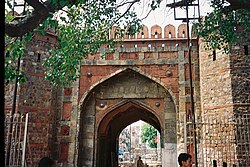Delhi Gate, Delhi
Coordinates: 28°38′28″N 77°14′26″E / 28.641196°N 77.240511°E
| Delhi Gate | |
|---|---|
 | |
| Location | Delhi, India |

Delhi Gate is the southern gate of many in the historic walled city of (Old) Delhi, or Shahjahanabad in 1638 AD. The gate links the New Delhi city with the old walled of Delhi. It stands in the middle of the road, at the end of Netaji Subhash Chandra Road (or Netaji Subhash Marg), at the edge of the Daryaganj.[1]
History[edit]
The Gate was built by Emperor Shah Jahan in 1638 as part of the rubble– built high fort walls that encircled the Shahjahanabad, the seventh city of Delhi. The emperor used this gate to go to the Jama Masjid for prayer.
Architecture[edit]
The gate is similar in design and architecture to the northern gate of the walled city, the Kashmiri Gate (1853). It was built in sandstone and is an impressive and large structure. Near the gate entry, two stone carvings of elephants were erected.
The road from this gate passes through Daryaganj leading to the Kashmiri gate. A part of the fort wall to the east has been demolished to build the Old Delhi Railway Station while the wall to the west exists.
The gate is now a heritage site maintained by the Archaeological Survey of India.[2][3][4][5]
See also[edit]
References[edit]
- ↑ City, So (27 March 2017). "Biryani & Kebabs, Lassi And The Daryaganj Book Market: The Delhi Gate Is One Buzzing Hub". So City. Retrieved 30 September 2021.
- ↑ Fanshawe.H.C. (1998). Delhi, Past and Present. pp. 1–8. ISBN 978-81-206-1318-8. Retrieved 10 June 2009.
{{cite book}}:|work=ignored (help) - ↑ "Commonwealth Games-2010, Conservation, Restoration and Upgradation of Public Amenities at Protected Monuments" (PDF). Qila Rai Pithora Wall. Archaeological Survey of India, Delhi Circle. 2006. p. 55. Archived from the original (pdf) on 11 October 2011. Retrieved 30 August 2013.
- ↑ Mahtab Jahan (2004). "Dilli's gates and windows". MG The Milli Gazette Indian Muslims leading new paper. Retrieved 17 May 2009.
- ↑ Patrick Horton; Richard Plunkett; Hugh Fnlay (2002). Delhi. pp. 92–94. ISBN 978-1-86450-297-8. Retrieved 13 June 2009.
{{cite book}}:|work=ignored (help)
